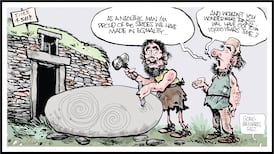In the 2014 movie A Million Ways To Die in the West, the humour arises from the main protagonist having a well-honed sense of personal risk, while living in a time and a place - the American Old West - where no-one else does.
From stray gunshots and hostile natives to un-hygienic food practices and runaway horses, in the ‘Wild West’ shown here almost everyone and everything is dangerous.
Possessing a modern awareness of safety issues in such an environment is to exist in a perpetual state of terror.
These days, the person who is hyper aware of potential threats is no longer the exception, although the actual health threat level that exists in developed societies such as Ireland is quite low.
However, maintaining a realistic sense of what is safe and unsafe, what is risky and what is not, has become increasingly difficult in a time of always on media, push notifications and ever more dramatic headlines clamouring for our attention by way of our fears.
Thus, we tend to worry more about terrorist attacks or plane crashes than getting in a car to drive to work, even though we are aware that the latter is statistically far more dangerous.
This has particular pertinence as we experience one of the more dramatic global health crises in recent times - the rapid spread of the Novel Coronavirus, the first cases of which have been confirmed on the island of Ireland in the past few days.
Disseminating information
Urgent questions now present themselves about how best to disseminate information as a means of slowing and containing the emerging pandemic.
How can professional communicators meet the need for clear and comprehensible information on a complex and fast-evolving issue, while encouraging a sense of perspective?
How do we strike a balance between avoiding panic leading to behaviour that runs counter to safety, and the kind of complacency that ultimately has a similar outcome?
On the side of the coin, how can the general public effectively engage with a flood of sometimes contradictory information and act in a way that is in their own and everyone else’s best interest?
It is well established that the diversity of media platforms and parallel decline of trust in mainstream media have contributed to a public sphere in which misrepresentation of basic health facts, both accidental and malicious, is more common than ever before.
Clear evidence links this to negative outcomes in various health-related areas, for example lower uptake of vaccination and participation in screening programmes, lack of trust in public health campaigns, and use of treatments by the public with a limited or non-existent evidence base.
A fast-moving and fluid scenario such as that presented by the Coronavirus outbreak is even more vulnerable to the spread of damaging misinformation.
This demands an informational strategy from the top down that is regular, comprehensive and localised.
Updates by key Government agencies must be responsive to emerging information and given on a regular basis, even where only to reiterate key details or describe the current picture on the ground. While government strategies in this regard have improved significantly in recent years, for example, in their response to severe weather events, a health issue like this one presents even more complex challenges.
Information gaps
Where informational gaps or unknowns exist, as is inevitably the case with a recently discovered pathogen, these must also be acknowledged.
The deliberate hiding or obfuscation of key detail with regard to the spread of the illness will only dilute public trust in official information sources. Alternative, often less reliable sources will quickly fill the gap.
Health authorities must also dovetail with local agencies to give area specific information. Updates that are perceived as geographically detached will also have a degrading effect on public trust levels. Utilising both national and local media in this regard is critical.
Established, reputable media has its own delicate line to tread right now. The nature of news reporting, where the most dramatic information usually leads, means risk factors tend to be amplified while actual quantifiable statistical probability goes the opposite direction.
Newsrooms must therefore be more cognisant than ever of their responsibilities to the public interest before giving prominence to the story of the narrative-led dramatic outlier.
For the moment, particularly in this crucial initial period of the crisis the ‘inform’ imperative should trump the ‘engage’.
In the longer term, there must be a greater emphasis on statistical reasoning as a critical tool for all kinds of professional communicators. If you can think straight about numbers, probability and their meaning, you will be able to write straight also.
At a key juncture in this flow of information, lies our own individual duty of care. Even as I type this, my phone is pinging with well-meant but ill-informed social media messages urging various means of avoiding infection or decrying ‘media blackouts’.
Ask yourself are you taking the time to think before you share or ‘like’? Consider for a moment whether the spread of misinformation might be almost as much of a threat to public health as the actual physical contagion itself.
Fergal Quinn is a lecturer in journalism at Univesity of Limerick. Together with Professor Ailish Hannigan and Dr Norma Bargary he is researching how the public conceptualises risk














